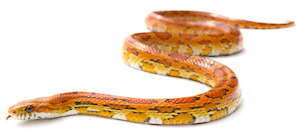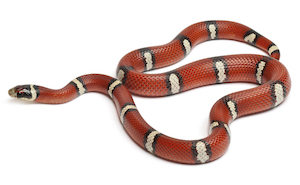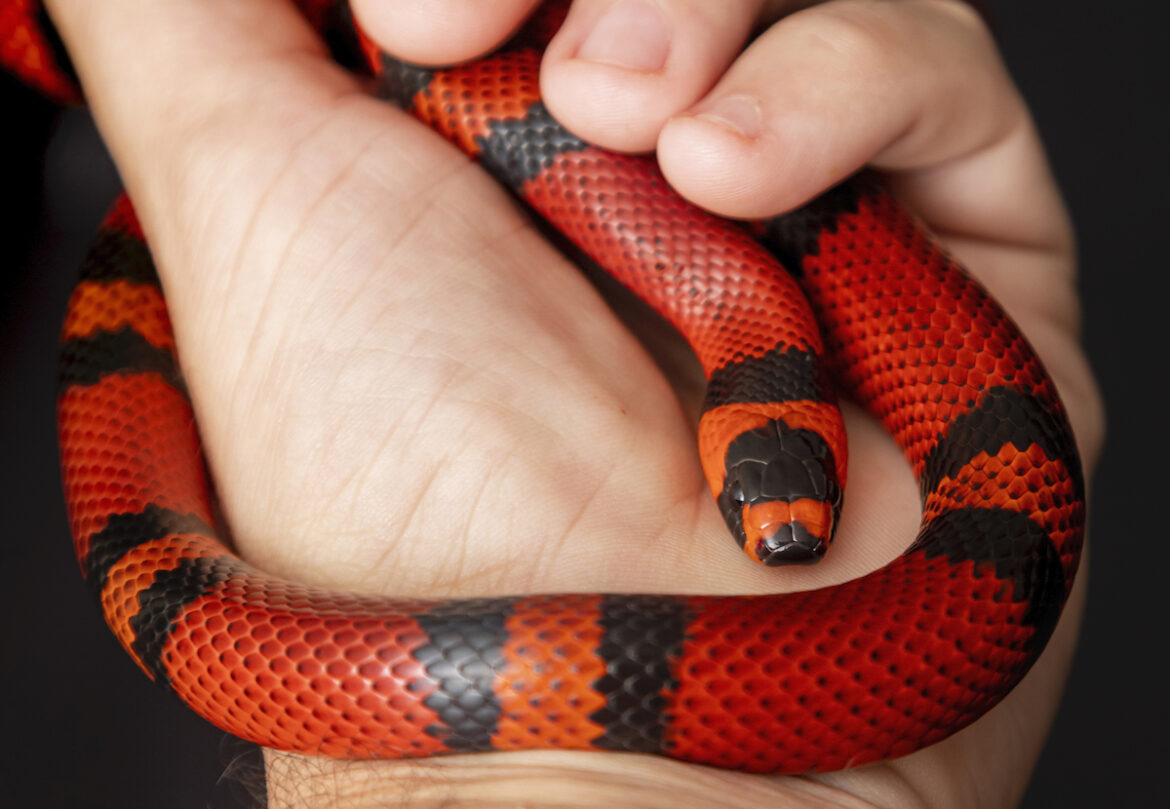Many animal lovers find the prospect of adopting a snake fascinating. Most snakes kept as pets are not only gorgeous animals but also have docile and independent personalities that make them the perfect companion for many.
However, there are so many different kinds of snakes out there to choose from. Not to mention, the upkeep of a snake is nothing like caring for a cat or dog. For example, you won’t be feeding your snake out of a food can, and they need a source of warmth available at all times.
If you can no longer resist your love for these beautiful and unique creatures, then it’s best to go for the ones that are easier to care for. If you’re a beginner keeper, your top choices are likely corn snakes or the milk snakes. They both make excellent pets for first-time snake parents.
But what are the differences between milk snakes and corn snakes? Both milk snakes and corn snakes are relatively small and docile pets with similar lifespans, habitats, and diets. However, they each come in different colors and patterns, and corn snakes are a bit easier to handle and less likely to bite.
Now, if you’re wondering which to choose, milk snake or corn snake, wonder no more. Yes, both these snakes are highly recommended for beginners. But, it’s always recommended to read about all the different aspects of these snakes to make up your mind as to which one will suit your lifestyle best.
Different Aspects Of Snakes To Consider
When you think of adopting a pet, some things are essential to evaluate, such as the number of years that the animal can live in captivity, their eating habits, the kind of habitat they require, and the size and weight they can be as an adult.
Some pet parents find the appearance of their reptiles to be of utmost importance as well. So, here’s looking at the differences and similarities between milk snakes and corn snakes.
1. Lifespan
In the wild, corn snakes have relatively shorter lives, living 6-8 years. But, when you provide these creatures with a safe haven, their lives can be much longer. Corn snakes can live an average of 20 years in captivity!
However, the milk snake’s lifespan isn’t so affected by a change in its environment. You see, milk snakes have a long life in the wild too. They can live up to 15 years in the wild on average. And, when they are captive, they will live up to 20 years.
Both the corn snake and milk snake are long-term commitments.
2. Size
The average adult corn snake grows between 24 – 72 inches, and it usually weighs around 900g. The male corn snake is often noticeably larger than the female.
In the wild, milk snakes can be anywhere between 14 – 69 inches. In captivity, milk snakes will feed more and can become quite heavy. They can weigh between 38 – 225g in the wild. But, within the safety of your home, they can weigh up to 750g or more.
There isn’t much of a size difference between the two snakes. Although the female and male milk snakes are sexually alike, that is to say; they have a similar length, color, and patterns. But the female corn snake is usually noticeably thicker (in width) than the male corn snake.
3. Habitat
Corn snakes are found in various habitats ranging from forested areas to overgrown fields. You can find corn snakes in the southeastern and central United States.
These snakes tend to stay closer to the ground until four months of age. After that, you can find them in trees, on cliffs, or on any elevated surfaces.
As a rule, these snakes are found in small, closed spaces such as logs or rock crevices in temperate climates in winter and under a house or pipelines in the summer, where it is generally cooler. But, like all snakes, corn snakes are known to come out of their hideout holes to soak up the sun.
Usually, you will find milk snakes in forested regions. They can be found in open prairies and rocky slopes as milk snakes are seen in Canada right down to Venezuela, South America. Milk snakes tend to migrate to higher, drier lands in winter and moist and warmer places in the summer months.
Both these snakes share similar mating and hibernation patterns. Both the milk and corn snake hibernate during the cold winter season. And both snake species soak up the sun in the summer season.
Due to these similarities in their natural habitat, the setups of their enclosures will be relatively similar, with substrate like leaf litter for them to burrow down into, branches to climb, and several hiding spots, as well as a basking rock.
4. Colors and Morphs

When it comes to looks, many animal lovers are attracted by the bright colors and intricate patterns found in various species of snakes.
Corn snakes come in various colors, but the three most common colors are red-orange, orange-yellow, and black. Usually, they have some kind of orange tint to their scales.
When speaking of corn snake morphs, you will literally find hundreds of different colors and patterns developed through breeding. Be warned, however, that the cooler the color, the higher the price.

Most milk snakes have smooth and shiny scales. Some milk snakes are found with bands, while others have blotches (or saddles) of color.
But the general color patterns are red-black or white-black-red. Generally, they are on the redder end of the spectrum.
Some milk snakes even bear a striking resemblance to the highly venomous coral snake.
The natural colors of milk snakes are so stunning that there truly aren’t a lot of different morphs yet. There are, however, 20 different species of milk snakes, and they’re actually a subspecies of kingsnakes.
If you want a snake that really stands out, this category really comes down to your personal preference for patterns and colors. Both of these species are visually stunning to look at.
5. Personality
Corn snakes are exceedingly calm and docile snakes. They don’t generally bite or strike even when stressed unless your hand smells like a tasty meal, and they are not constrictors.
Exotic vets recommend these snakes for their mild demeanor. But be warned that baby corn snakes aren’t so gentle, as they can be nippy when they are scared. Once they’re used to your presence, corn snakes seem to enjoy being handled from time to time.
As with many young snakes, wild-caught milk snakes will shake their tails to mimic rattlesnakes, musk, or even bite when frightened. These are all defensive behaviors, not meant to hurt you but scare you away. In fact, a bite from one of these tiny, non-venomous snakes isn’t even as painful as getting a papercut.
However, captive-bred milk snakes tend to be much more laid-back and handleable. And, once milk snakes are grown up and used to you and their habitat, they make friendly and entertaining companions. Like most smaller snakes, milk snakes are usually very active and curious.
As one of the more active snakes, they can tend to be hard to handle in the sense that they are always moving. Unlike a ball python, you can’t just wrap them around your arm and expect them to stay there for a while. They’ll want to move about and explore. If you’re looking for an entertaining pet, this one’s for you.
Although, milk snakes absolutely love to eat, which means they’re constantly on the hunt for a tasty snack. Unfortunately, your warm hand can easily be mistaken as prey, which makes these snakes a bit more likely to bite.
While a bite from a milk snake is non-venemous and relatively pain-free, as they don’t have any teeth or fangs, it can certainly be startling, especially for children. Such an incident is more likely to result in injury to the snake than to you, from dropping or otherwise accidentally hurting your snake.
Either of these snakes will make a great pet for beginners, as long as you know what to expect and how to properly handle and socialize your snake. Of course, you’ll also want to provide them with a stress-free environment equipped with everything they need to stay happy and healthy.
5. Diet
Perhaps one of the most critical elements when it comes to the overall health of your snake is its diet. All snakes are carnivores. There’s no getting around it. However, each snake has different dietary needs.
Most keepers feed their snakes mice, rats, and crickets of various sizes. In some cases, snakes can even eat small fish. In the wild, their diets are even more varied, from small reptilians and frogs to birds and eggs.
One of the many reasons corn snakes are great for first-time serpent parents is that they aren’t fussy about food. They’ll eat everything you give them without hassle. Their only demand is for the food to be plentiful and served on time.
As to what they eat? Mice and rats, of course. They’re a subspecies of rat snakes for a reason. You don’t have to worry that you’ll have to go on a rat hunt every day to feed your beloved pet, as they only eat once every 7-10 days and many pet stores sell humanely frozen rats and mice for feeding purposes.
In the wild, milk snakes eat a wide variety of meat, from birds, small rodents, and even other reptiles. For this reason, wild-caught milk snakes can be picky eats, but captive-bred milk snakes aren’t usually picky about their food if they’ve been raised on mice and rats. Though, it certainly doesn’t hurt to add some variety.
6. Breeding
Many snakes differ when it comes to breeding, as some can lay a clutch of dozens of eggs and some snakes don’t lay more than just a few. Some snakes even give birth to live babies.
Corn snakes tend to mate and breed after hibernation in the wild. In captivity, corn snakes can mate and reproduce more than twice a year, though it’s generally seen as an unhealthy practice for breeders to try and implement.
The female corn snake will lay between 12-24 eggs in a warm, moist, and safe place. Then the female snakes leave to hatch in ten weeks. And the baby corn snake is usually about five inches in length.
If you plan on breeding your corn snake, you’ll need to remove the eggs and place them in an egg incubator (this is a great option) to ensure that the eggs hatch, as there is no concept of egg nesting with corn snakes.
Milk snakes typically lay around 10 eggs after mating during hibernation. They tend to mate closer to spring so that the babies have plenty of food supply when they hatch.
They breed in late May or early June, and the eggs hatch two months later. The average size of a milk snake soon after hatching is approximately 8 inches.
You must remove the eggs once the female is through laying to place them in an incubator. Milk snake eggs hatch faster, and they have larger-sized babies, making it easier for pet parents to care for them. Corn snakes will give you more babies, but you’ll have to be exceedingly careful feeding and caring for these delicate little ones.
Conclusion
There isn’t a doubt that both the corn snake and the milk snake make fantastic pets. Milk snakes are beautiful and complex creatures to behold. Many snake lovers find them intriguing pets and are lured towards them due to their beautiful colors and interesting personalities.
And corn snakes are exceptionally easygoing when bonding and making a connection between pet and pet parent. Many snake parents even claim that their corn snake gets excited to be handled. And yes, snakes can and do feel certain emotions.
Both pets are long-term commitments that will need your care and attention. So never adopt for the sake of the novelty, as that wears off pretty quickly. And don’t adopt if you can’t spare your pet any time. They need to be socialized and cared for on a consistent basis for their health and enrichment.
Adopt only when you are very serious about your commitment to these creatures. And always make it a point to give your serpent-babies the love and care they deserve. Furthermore, it always helps to read up on the topic to help you understand your pet’s needs.
Before you go, if you’re looking for even more info on these awesome animals, we’ve found two great videos for you by Clint’s Reptiles on YouTube. Check them out below!
Up Next: The Best Hides For Snakes
